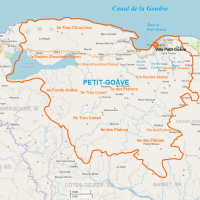Petit-Goave

Petit-Goâve (Kreyol: Piti gwav), one of the first cities to be established in Haiti, was inhabited by the Amerindians, who named it Goâve. It became Aguava when the Spanish colonists settled it. Eventually the French acquired and divided it, re-naming it Grand-Goâve and Petit Goâve. Petit Goâve, served as the temporary capital of Saint-Domingue, a wealthy colony.
The city celebrated its 350 year landmark anniversary with a three day celebration, beginning on a Friday, throughout which many events showcasing history, Haitian society and culture were put on. A guest of honor to the ceremonies was Haitian-Canadian author, Dany Laferrière, whose honor in the French language, with his election into the French Academy, makes him one of the world’s 40 authorities on the language. Since Petit-Goâve is his hometown, Laferrière felt it best to celebrate both events as one with a visit.
Earthquake: Petit-Goâve was seriously damaged in the aftermath of the 2010 earthquake when a strong 5.9 aftershock struck at the epicenter of which Petit-Goâve lay close to. A week later the U.S. Marines arrived in Petit- and Grand-Goâve to bring aid supplies.
The city of Petit-Goâve was founded in 1625 and raised to the rank of commune in 1663. Located in the passage of the Route Nationale 2, The Municipality of Petit-Goâve has twelve communal sections. It is coastal, its dominant relief is the hills and its climate varies from hot to cool. Its inhabitants bear the name Petit-Goâvien. The city has a hospital, 3 high schools, 5 volleyball clubs and 3 football (soccer) clubs. In 1998, the population of Petit-Goâve was estimated at 124,855 inhabitants with a density equal to 331 inhabitants / km2. In 2015, the population is _ . At 3 km/2 (1.3 square miles), the urban section has a density equal to 35,990 residents per km/2 (95,235 residents per square mile).
Transportation: On Wednesday, October 21, 2015, President Martelly inaugurated the port of Petit-Goâve in the presence of both the Director General of Customs (AGD) and the Director General of the National Port Authority (APN). The construction of the port in an area covering 52 square meters took ten months to complete with a State fundings of $2.3 million.
The new port has been renovated with new customs offices and bonded warehouses built in accordance with the ISPS Code (International Code Ship and Port Security). It has the capacity to receive 2,000-ton boats along a long coastline of 1,500 meters. The construction work was a part of the area development work for enhancing competitiveness and overall development of Haiti.
Education: The Ministry of National Education of Youth and Sports is represented in the Municipality of Petit-Goâve by a school inspection office. Six kindergarten, some mostly private primary schools and twelve secondary schools have been inventoried in the commune.
The Ministry of Public Health and Population is represented in the Municipality of Petit-Goâve by a Communal Office. One hospital, six dispensaries, a health center with bed, and seven clinics were registered in the commune with a team of doctors (graduates and trainees), dentists , nurses, auxiliaries, certified matrons and technicians.
Utilities: The community has six rivers, five springs, two ponds and a lagoon. Five traditional wells and public fountains with nine faucets were also listed. Electricity of Haiti is the institution that ensures the distribution of the current in the city of Petit-Goâve which is the only electrified zone. Thanks to an electric motor, this current is provided for 84 hours a week.
Security: For Administrative and Judicial Infrastructures, the municipality has a Commissariat, two Courts of Peace, a Civil Court and a Public Prosecutor’s Office. There is also a prison.
Religion: On the side of Religion, nearly 150 temples of all beliefs have been enumerated in the commune. The number of Pentecostal churches is the most numerous, thirty-six in total.
Organizations: Seven political parties have representation in the commune of Petit Goâve. In addition, thirteen Peasant Groups, one Womens’ Group, four non-commercial Cooperatives, and two international organizations were counted.
Communication: In terms of communication, the municipality has a telephone office, four radio stations, a newspaper / magazine and a television station.
Leisure: As for Leisure, the commune of Petit-Goâve has a public library and a cinema room. There is no museum, nor theater. Football (soccer), volleyball, basketball and cycling are the sports practiced in the municipality. In addition, there are four nightclubs, and four public places. In terms of Cultural Heritage, the town has two forts and three beaches. Every August 15, the town of Petit-Goâve celebrates its patron saint by receiving a large number of visitors.
Recently Minister of Tourism, Stephanie Balmir Villedrouin, has uncovered natural features of Petit-Goâve that make it a potential tourist destination. She, together with a Ministry of Tourism delegation and Petit-Goâve Mayor, Sandra Jules, went on an exploratory mission. They visited underdeveloped tourist attractions with a view to develop them, to increase tourist spending there.
The government of Haiti has approved funding for three projects in Petit-Goâve along the shoreline, to make the area more desirable to tourists. The projects include renovations of public beaches Mon Repos, Cocoyer, and Banana Cocoyer.

